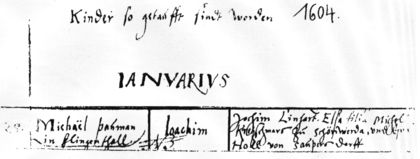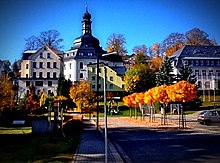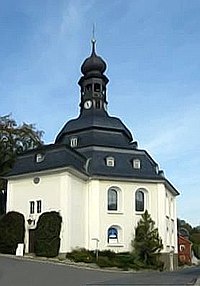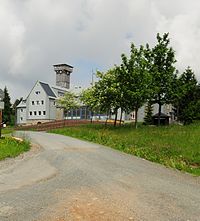Klingenthal
| coat of arms | Germany map | |
|---|---|---|

|
Coordinates: 50 ° 22 ′ N , 12 ° 28 ′ E |
|
| Basic data | ||
| State : | Saxony | |
| County : | Vogtland district | |
| Height : | 569 m above sea level NHN | |
| Area : | 50.44 km 2 | |
| Residents: | 8184 (Dec. 31, 2019) | |
| Population density : | 162 inhabitants per km 2 | |
| Postcodes : | 08248, 08267 | |
| Primaries : | 037467, 037465 | |
| License plate : | V, AE, OVL, PL, RC | |
| Community key : | 14 5 23 160 | |
| LOCODE : | DE KGT | |
City administration address : |
Kirchstrasse 14 08248 Klingenthal |
|
| Website : | ||
| Lord Mayor : | Thomas Hennig ( CDU ) | |
| Location of the city of Klingenthal in the Vogtland district | ||

Klingenthal , until 2007 Klingenthal / Sa. , is a large district town in the southeast of the Saxon Vogtlandkreis . It is located in the Musikwinkel in the Erzgebirge / Vogtland Nature Park . The city gained fame through the manufacture of musical instruments , as a holiday resort in the Vogtland and as a winter sports resort.
geography
Klingenthal is right on the border with the Czech Republic , across from Kraslice (Graslitz) , at the foot of the Aschberg ( 936 m above sea level ) . The 10.5 km long town is surrounded by coniferous forest (mainly spruce). Klingenthal is located in the southeast of the Saxon part of the historic Vogt country , but heard with respect to the natural environment for Westerzgebirge . The urban area lies in the Ore Mountains / Vogtland Nature Park .
The Brunndöbra and the Zwota flow through Klingenthal . Both unite on the German-Czech border to the border river Zwotau , which flows into the Eger .
Important mountains around Klingenthal:
- Kiel (942 m)
- Aschberg (936 m)
- Schwarzberg (802 m)
- Bleiberg (802 m)
City structure
The city of Klingenthal consists of three districts, which fulfill a function as a village with its own local council.
| Localities | Districts |
|---|---|
| Klingenthal | Klingenthal (with Döhlerwald , Huth , Kriegberg [today: Körnerberg / Friedensberg], Quittenbach and Unterklingenthal ), Brunndöbra (with Mittelberg ), Sachsenberg-Georgenthal (consisting of Sachsenberg [Obersachsenberg and Untersachsenberg] and Georgenthal [with Aschberg and Steindöbra ]) |
| Mühlleithen (since April 1, 1992) | Mühlleithen, Winselburg |
| Zwota (since January 1, 2013) | Oberzwota , Zwota (with Zechenbach ) |
Neighboring communities
The neighboring communities in the Vogtlandkreis are Markneukirchen , Schöneck / Vogtl. , Grünbach and Muldenhammer . In the Czech Republic there are the neighboring communities of Kraslice (district Hraničná ) and Bublava .
history

Sebastian Köppel built a hammer mill on the Zwota near the Bohemian border in 1591 to use the nearby deposits of iron ore and the extensive forests in the region. On February 1, 1602 then took place, the first mention of the name "Höllhammer" in the church book of the city Schoeneck . At that time, hammer smiths , miners and charcoal burners lived there . Mining was mainly carried out in the area of Brunndöbra and in the valley of the Dürrenbach. In 1628 the hammer mill burned down. Except for the Hammergut, it was not rebuilt.
In the middle of the 17th century, Bohemian exiles who emigrated in the course of the Counter Reformation introduced violin making in Klingenthal . In 1716 a violin makers' guild was founded. At the end of the 18th century, bow making, string making and the manufacture of wood and brass instruments followed in Klingenthal. In 1829 the harmonica production and the wooden comb production were added, in 1852 the production of the hand harmonica , later the accordion. Klingenthal became a world center of harmonica production in the second half of the 19th century . The older branches of the musical instrument trade were largely displaced by the harmonica instruments. Klingenthal has had a railway connection since 1875.
Klingenthal was in the Electoral Saxon or Royal Saxon Office of Voigtsberg until 1856 . From 1856 the place was the administrative seat of the court office in Klingenthal . In 1875 the place came to the Auerbach administration .
At the beginning of the Nazi era , political opponents of the Nazi regime were mistreated in the cellar of the town hall and on the site of the former Bräcklein barn in April and May 1933 and then deported to various concentration camps. The memorial erected in her memory was demolished in 1994 against the resistance of relatives of the persecuted. In 2016, on the initiative of the VVN-BdA Vogtland, a “Room of Remembrance” was set up in the town hall, in which the first Klingenthal victims of fascism are remembered.
The city charter Klingenthal received on October 1, 1919. On July 25, 1952 from parts of the former districts was Auerbach and Oelsnitz the county Klingenthal in the district of Chemnitz (in 1953 the city Karl-Marx-district renamed) formed in 1990 as a Saxon district Klingenthal continued has been. Since 1996 Klingenthal has belonged to the Vogtlandkreis , whose administrative seat is Plauen . In contrast to Klingenthal in Alsace, the official name of the city until January 31, 2007 was Klingenthal / Sa. With resolution 377 (published in the city's official gazette on February 9, 2007) the addition Sa. was deleted, and since then the city has been called Klingenthal after this resolution . It has had the status of a major district town since 2019.
The peculiarities of the mountain landscape have made winter sports at home in Klingenthal since the beginning of the 20th century. The achievements of the Klingenthal ski athletes have influenced the location and level of Nordic skiing internationally. After the turn of the millennium, the Ski Jumping World Cup was held several times in Klingenthal .
Incorporations
On July 1, 1950, Brunndöbra and Sachsenberg-Georgenthal were incorporated into Klingenthal . Mühlleithen was added on April 1, 1992, and finally Zwota on January 1, 2013 .
Population development
The sudden increase in the number of inhabitants in 1950 is due to the incorporation of Brunndöbra and Sachsenberg-Georgenthal . During the GDR era, the population of the heavily industrialized city was already falling again. The economic decline after the political change favored this process. Another factor that promotes this development is the availability of cheap labor from the Czech Republic, which has been linked to the city by road and rail border crossings since 2001. However, as wage levels in the Czech Republic and Germany gradually converge, this effect could noticeably weaken.
However, the population is no longer falling as drastically as it was a few years ago, in 2020 the city is expected to have between 7800 and 7400 inhabitants. The proportion of over 65-year-olds is expected to rise to almost a third of the total population by 2020 and thus corresponds to other municipalities in the Free State of Saxony . The proportion of 15 to 65-year-olds is expected to decrease by around 10% and thus reach around 55%. The number of children under 15 years of age could, however, increase from 8% to 10% and would therefore be higher in 2020 than in neighboring cities such as Markneukirchen .
Development of the population (from 1960 December 31) :
|
1834 to 1946
|
1950 to 1999
|
2000 to 2010
|
2012 to 2018
|
* October 29th ** August 31st
politics
City council
Since the municipal council election on May 26, 2019 , the 18 seats of the city council have been distributed among the individual groups as follows:
- CDU : 7 seats
- Pro Klingenthal - my city eV (Pro): 6 seats
- Free Community of Voters Klingenthal (FWG): 5 seats
Lord Mayor
Until March 2010, Reiner Schneidbach (CDU) was mayor of Klingenthal, from April 2010 Enrico Bräunig (SPD) held this office. He retired on December 31, 2012. At the first meeting of the city council on January 10, 2013, the head of the office, Inge Schneider, was appointed administrator , who took over the business of the mayor until his new election. The mayoral election took place on March 24, 2013. In this election, the previous mayor of Zwota, Thomas Hennig (then non-party) prevailed against four competitors. He received 97.59% of the vote with a turnout of 50.2%. With his appointment as a major district town, Thomas Hennig became Lord Mayor on August 8, 2019.
Coat of arms, flag and official seal
The city of Klingenthal has a coat of arms, a flag and an official seal.
- Description of coat of arms
"The coat of arms of the city of Klingenthal shows a yellow lyre on a blue background."
- flag
"The city of Klingenthal uses a yellow-blue stripe flag with an applied city coat of arms."
- Official seal
“The official seal of the city bears the city coat of arms with the inscription 'Stadt Klingenthal' and the seal number or the name of the office. The mayor is responsible for managing the seal. "
Town twinning
Klingenthal maintains city partnerships with:
- Kraslice (Graslitz), Czech Republic , since 1952
- Neuenrade , North Rhine-Westphalia , since 1990
- Castelfidardo , Italy since May 2003
Culture and sights
Museums and open-air facilities
- Klingenthal Music and Winter Sports Museum
- Arboretum "An der Braunleithe" in the forest district of Adorf (located in the Brunndöbra district)
- Klingenthal Zoo on Richard-Wagner-Höhe (opened in 1963)
- Zwota Harmonica Museum in the former school building
- Accordion foam factory - closed since January 1st, 2011
music
- City Orchestra Klingenthal 1866 e. V.
- Church concerts in the round church Zum Friedefürsten
- International accordion competition
- Men's choir Goldbergchor
- Wind orchestra Lindenkapelle
- Klingenthal eV accordion orchestra
- Trumpet and church choirs of the individual parishes
- Harmonica Live Festival
Religions and churches
- Evangelical Lutheran Churches:
- City Church of the Prince of Peace (built 1736–1737)
- Luther Church, Brunndöbra (built 1909)
- St. Johannis Church, Sachsenberg-Georgenthal (built 1872)
- Roman Catholic Church:
- Church Maria Rosenkranz Queen (built 1872)
- Brethren Movement (Free Church)
Buildings
- Large hill at the Vogtland Arena
- Klingenthal Youth Hostel
- Hiking observation tower "Otto Hermann Böhm": - The observation tower , built in 1999, has a total height of 32 m and a site height of over 900 m above sea level. NN and is located next to the Klingenthal Youth Hostel on the Aschberg, built in 1929, just next to the border with the Czech Republic.
Natural monuments in the area around Klingenthal
- Topaz rock Schneckenstein
- Great Kranichsee high moor nature reserve
- Arnica Meadow Winselburg
- Radium source in the Steinbachtal
Sports
- Vogtland Arena
- Klingenthal / Mühlleithen cross-country ski center : 110 km of well-groomed cross-country ski runs lead around Klingenthal. Sports competitions take place here ( e.g. Kammlauf ).
- Ski lifts: There are 3 ski slopes with different levels of difficulty in the area.
- Klingenthal tennis club: The TCK has 3 modern tennis courts in the Zwota district .
- With the SC Dynamo Klingenthal , one of the GDR winter sports centers was based in the city.
Regular events
Every year in May, the Klingenthal International Accordion Competition is held, which is highly regarded by experts around the world.
There are also regular concerts in the park. Two wind orchestras, an accordion orchestra and numerous smaller music groups are known from radio, television and records.
Another important event is Harmonica Live every third weekend in September. In addition to the workshops for amateurs and professionals, the highlight of the international harmonica festival is the musical and culinary live night with harmonica music in numerous Klingenthal restaurants. The musical palette ranges from folk to blues , jazz , Dixieland to country .
Church concerts are regularly given in the round church "Zum Friedefürsten" .
Economy and Infrastructure
Business
- CA Seydel Sons , harmonica factory
- Hospitality, especially for hiking and winter sports tourism
- Seat of some companies and institutions for research and development, for the construction and repair of musical instruments and music electronics
- Metal processing companies
- forestry
- Production of medical products
- Manufacture of electronic components, for example for the rail industry
- Manufacture of electronic accessories for model railways
traffic
Klingenthal is located on the railway line from Zwickau to Sokolov (Falkenau / Eger) , which is operated today by the Vogtlandbahn (Zwickau - Klingenthal (border)) and the Czech railway company GW Train Regio (Klingenthal (border) - Sokolov). The Vogtlandbahn has connections every hour to the center of Zwickau and to Kraslice- Sokolov from 6 a.m. to 10 p.m., on Mondays to Fridays the route is operated between 5 a.m. and 11 p.m. On Saturdays there is also the possibility to go to Karlsbad , Marienbad and Hof .
The Klingenthal train station and its surroundings were embellished by 2011 . This was initiated at the end of September 2011 with the demolition of the mighty reception building. From 1917 to 1964 the electrically operated narrow-gauge railway Klingenthal-Sachsenberg-Georgenthal with a gauge of 1,000 mm ran in the Döbratal between Klingenthal and Sachsenberg-Georgenthal .
Their relation wrong today, the city bus line 48, achieved with the one from the train station to the city center in a few minutes. In addition to the city bus, there are several regional bus routes.
The B 283 runs through Klingenthal , from the Graslitzer Strasse intersection as Auerbacher Strasse (to the northeast; formerly Leninstrasse) and Markneukirchner Strasse (to the west). There are four connections across the border between Germany and the Czech Republic in Klingenthal:
- Railway border crossing on the Zwickau-Sokolov line
- Car border crossing Klingenthal - Graslitz on the B 283
- Car border crossing Aschberg - Schwaderbach
- Hiking crossing Klingenthal / Aschberg - Bublava
education
- Vocational and vocational school "Vogtland Musical Instrument Making" Klingenthal
- District adult education center
- Music School Vogtland e. V.
- School center "Am Amtsberg" (elementary school, grammar school with an in-depth sporting and mathematical and scientific profile, middle school)
Personalities
Movies
- Once is never (also known as “This is how it sounds in Klingenthal”). Feature film, GDR 1955. Director: Konrad Wolf , music: Günter Kochan
literature
- Wilfried Heller : Klingenthal - quo vadis? Effects of social change in a small town on the Saxon-Bohemian border . Chemnitz 1995 (articles on local and regional development, issue 15), ISSN 0942-5934 .
- Wir-Verlag Walter Weller (ed.): Klingenthal . Wir-Verlag Walter Weller, Aalen 1991, ISBN 3-924492-59-X .
- Kurt Erich Dörfel: History of the places of the district of Klingenthal . Publishing house Gustav Bergmann, Klingenthal 1930.
- Arthur Müller: Looks into the past of Klingenthal and the surrounding towns of Brunndöbra, Unter- u. Obersachsenberg, Georgenthal, Aschberg, Steindöbra, Mühlleithen with Winselburg, Kottenheide and Zwota. Taking into account the neighboring Bohemian towns. Brückner & Niemann, Leipzig 1897 ( digitized )
- Richard Steche : Klingenthal. In: Descriptive representation of the older architectural and art monuments of the Kingdom of Saxony. 9th booklet: Auerbach District Authority . CC Meinhold, Dresden 1888, p. 5.
Web links
- Klingenthal website
- Klingenthal in the Digital Historical Directory of Saxony
- Literature about Klingenthal in the Saxon Bibliography
- Music & Winter Sports Museum
- Historical pictures of Klingenthal and its districts on a private website
References and comments
- ↑ Population of the Free State of Saxony by municipalities on December 31, 2019 ( help on this ).
- ↑ The mining around Klingenthal in the book "Sächsischer Erzbergbau"
- ^ Karlheinz Blaschke , Uwe Ulrich Jäschke : Kursächsischer Ämteratlas. Leipzig 2009, ISBN 978-3-937386-14-0 ; P. 74 f.
- ^ The Auerbach administration in the municipality register 1900
- ↑ a b Thorald Meisel: Ritt zur Fusion began ten years ago. In: Free Press . January 6, 2020, accessed January 22, 2020 .
- ↑ Results of the 2014 municipal council elections
- ^ City of Klingenthal: The city council
- ↑ Result of the mayoral election of March 24, 2013 on www.statistik.sachsen.de. Retrieved March 26, 2013 .
- ↑ a b c main statutes of the city of Klingenthal (PDF; 146 kB)
- ↑ town twinning. In: Neuenrade website. Retrieved January 22, 2020 .
- ↑ Arboretum "An der Braunleithe" on arboreten.de
- ↑ Klingenthal Zoo on the Klingenthal website
- ↑ Information from harmonica live
- ↑ Website of the BFS Klingenthal. Retrieved December 13, 2019 .










